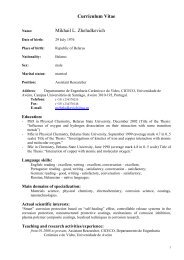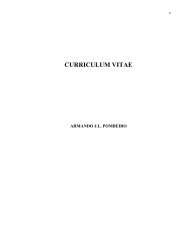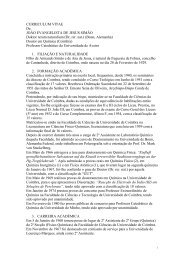XII Iberian Meeting of Electrochemistry XVI Meeting of the ...
XII Iberian Meeting of Electrochemistry XVI Meeting of the ...
XII Iberian Meeting of Electrochemistry XVI Meeting of the ...
Create successful ePaper yourself
Turn your PDF publications into a flip-book with our unique Google optimized e-Paper software.
<strong>XII</strong> <strong>Iberian</strong> <strong>Meeting</strong> <strong>of</strong> <strong>Electrochemistry</strong> & <strong>XVI</strong> <strong>Meeting</strong> <strong>of</strong> <strong>the</strong> Portuguese Electrochemical Society PB 12<br />
Bacterial cellulose: A new material for cell immobilization in<br />
biosensors<br />
Manuel J. Matos 1,2 , Nelson A. F. Silva 2 , Amin Karmali 2 , Edison Pecoraro 3<br />
1 Instituto de Telecomunicações, Pólo de Lisboa, Portugal<br />
2 CIEQB-ISEL - Instituto Superior de Engenharia de Lisboa, Portugal<br />
3 Instituto de Telecomunicações, Pólo de Aveiro, Portugal<br />
mmatos@deq.isel.ipl.pt<br />
A biosensor is an analytical device capable <strong>of</strong> quantifying <strong>the</strong> amount <strong>of</strong> a given analyte<br />
by means <strong>of</strong> a transduction process <strong>of</strong> a biochemical signal that results from an<br />
interaction between a biological recognition element and <strong>the</strong> analyte itself.<br />
A particular a concerns <strong>the</strong><br />
immobilization <strong>of</strong> <strong>the</strong> biological element, which can be made directly on <strong>the</strong> surface <strong>of</strong><br />
<strong>the</strong> transducing element or by means <strong>of</strong> an auxiliary support which, <strong>the</strong>n, is placed in its<br />
immediate vicinity. Encapsulation matrices, polymeric membranes or sol-gel technology<br />
are examples <strong>of</strong> <strong>the</strong>se immobilization methods. However, <strong>the</strong>se matrices or<br />
immobilization supports are mostly syn<strong>the</strong>tic, which, may result in a biologic<br />
incompatibility between <strong>the</strong> recognition element and <strong>the</strong> immobilization support. This<br />
aspect may lead to some limitations such as reduction <strong>of</strong> biological activity, premature<br />
<br />
To overcome this limitation, our group was able to successfully immobilize living<br />
microorganisms (whole bacterial cells) on a new material that consists <strong>of</strong> a biological<br />
substance resulting from <strong>the</strong> metabolism <strong>of</strong> o<strong>the</strong>r microorganisms, processed in order to<br />
fulfill our main immobilization purposes. This material, referred to as bacterial cellulose<br />
or biocellulose, allowed us to achieve very promising results in living cells<br />
immobilization [1, 2].<br />
In this presentation we compare some analytical characteristics <strong>of</strong> an electrochemical<br />
biosensor with potentiometric transduction, used for acrylamide detection, when using<br />
biocellulose and o<strong>the</strong>r traditional matrices, such as polymeric membranes, for <strong>the</strong><br />
immobilization <strong>of</strong> whole cells <strong>of</strong> Pseudomonas aeruginosa [3]. Parameters such as<br />
linear rangewere<br />
considered.<br />
References<br />
[1] Iguchi, M.; Yamanaka, S.; Budhiono, A.; J. Mat. Sci, 2000, 35, 261.<br />
[2] Pecoraro, E.; D. M. Manzani; Y. M. Messaddeq; S. J. L. R. Ribeiro; Monomers, Oligomers,<br />
Polymers and Composites from Renewable Resources, Ed. by Naceur Belgacem and<br />
Alessandro Gandini, Elsevier Science, 2008.<br />
[3] Silva, N.; Gil, D.; Karmali, A.; Matos, M.; Biocat Biotransf, 2009, 27, 143.<br />
September, 811, 2010. ISEL - Lisbon 78








